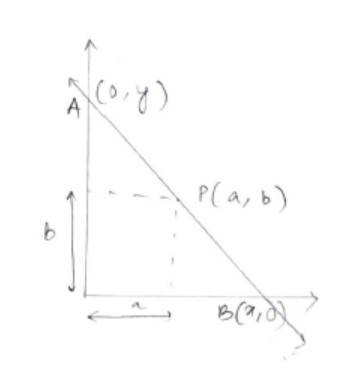Maths
Get insights from 6.5k questions on Maths, answered by students, alumni, and experts. You may also ask and answer any question you like about Maths
Follow Ask QuestionQuestions
Discussions
Active Users
Followers
New answer posted
6 months agoContributor-Level 10
34.
Since P (a, b) is the mid-point of the line segment say AB with points A (0, y) and B (x, 0) we can write,
So, the equation of line with x and y intercept 2a and 2b using intercept form is
Hence, proved
New answer posted
6 months agoContributor-Level 10
5. Given, A = {1,1}
So, A* A = { (1,1), (1,1), (1,1), (1,1)}
A *A *A = { (1,1), (1,1), (1,1), (1,1)} * {1,1}
= { (1,1.1), (1, 1), (1, ), (1,1,1), (1,1,1), (1,1), (1,1), (1,1,1)}
New answer posted
6 months agoContributor-Level 10
The n is , which is a and is set of all non-zero real numbers
For,
So, is one-one
For, such that
So,
So, every element in the co-domain has a pre-image in
So, is onto
If such that
For,
So, is one-one
For, and we have
Eg., so
So, is not onto
New answer posted
6 months agoContributor-Level 10
4. (i) False. Here P = {m, n}, n (p)=2
Q = {n, m}, n (Q)=2
n (P* Q) = n (P)* n (Q) = 2* 2 = 4.
So, P *Q = { (m, n), (m, m), (n, n), (n, m)}
(ii) True.
(iii) True. { A * (B ∩ ?) = A* ? . {∴ B ∩ ? = ? }
= n (A) *0 {? is empty set}
= ?
New answer posted
6 months agoContributor-Level 10
33. Assuming the price per litre say P in x-axis and the corresponding demand say D in y-axis, we have two point (14, 980) and (16, 1220) in xy plane. Then the points (P, D) will satisfy the equation.

Which is the required relation
Where P = 17, we have
D = 120 * 17 – 700
D = 1340
Hence, the owner can sell 1340 litres of milk weekly at? 17/litre
New answer posted
6 months agoContributor-Level 10
The given relation in set N defined by
For (2,4), 4>6 is not true
For (3,8), 8>6 but 3= 8-2 ⇒3=6 is not true
For (6,8), 8>6 and 6= 8-2 ⇒6=6 is true
And for (8,7), 7>6 but 8= 7-2 ⇒8=5 is not true
Hence, option (C) is correct
New answer posted
6 months agoContributor-Level 10
The set in
The relation in this set is given by
is reflexive as
As, but
is not symmetric
For and
And for and
∴ is transitive
Hence, option (B) is correct
New answer posted
6 months agoContributor-Level 10
The given relation in the set all lines in plane is defined as
is parallel to
Let then as is parallel to ,
So, is reflexive
Let and
Then, is parallel to
is parallel to
So,
i.e., is symmetric
Let and and
Then, and
So,
i.e.,
So, is transitive
Hence, is an equivalence relation
The set of lines related to is given by the equation where is some constant.
New answer posted
6 months agoContributor-Level 10
The given relation in set A of all polygons is defined as
R= and have same number of sides
Let ,
As number of sides = number of sides
So, R is reflexive.
Let and
Then, number of sides of = number of sides of
Number of sides of = number of sides of
i.e.,
so, R is symmetric.
Let and and
Then, number of sides = number of sides
Number of sides = number of sides
So, number of sides = number of sides
I.e.,
So, R is transitive.
Hence, R is an equivalence relation.
New answer posted
6 months agoContributor-Level 10
The given relation to set A of all triangles is defined as
R= is similar to
For ,
is always similar to
So, . Hence R is reflexive.
For and we have
i.e.,
so, R is symmetric.
for, and and
and
i.e.,
so, R is transitive
R is an equivalence relation.
Given, sides of are 3,4,5
Sides of are 5,12,13
Sides of are 6,8,10
As we conclude that is not similar to
As we conclude that is not similar to
But as we conclude that
Taking an Exam? Selecting a College?
Get authentic answers from experts, students and alumni that you won't find anywhere else
Sign Up on ShikshaOn Shiksha, get access to
- 65k Colleges
- 1.2k Exams
- 679k Reviews
- 1800k Answers

